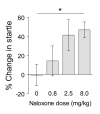Protracted manifestations of acute dependence after a single morphine exposure
- PMID: 21833504
- PMCID: PMC3978778
- DOI: 10.1007/s00213-011-2425-y
Protracted manifestations of acute dependence after a single morphine exposure
Abstract
Rationale: Acute opiate exposure produces a state of dependence in humans and animals, which is revealed by signs and symptoms of withdrawal precipitated by opioid receptor antagonists. The physiological changes that underlie this state of acute dependence develop rapidly and can persist long after the end of chronic opiate exposure.
Objectives: The purpose of this investigation was to determine the persistence of acute dependence after a single morphine exposure in rodents, focusing on changes in behavior thought to reflect the negative emotional consequences of withdrawal.
Methods: The acoustic startle reflex and conditioned place aversion were measured following naloxone administration at different time points after a single morphine exposure.
Results: Naloxone administration produced significant potentiation of acoustic startle-a form of anxiety-like behavior-for at least 80 days after one exposure to morphine. In contrast, naloxone produced a conditioned place aversion 24 h but not 20 days after one morphine exposure.
Conclusions: Together with existing literature, these results suggest acute as well as chronic opiate exposure leave rodents persistently vulnerable to express anxiety-like behavior in response to opioid receptor antagonists or stressful experience. The adaptations in brain function that underlie this protracted state of dependence may provide a foundation for the escalation of withdrawal severity that develops over repeated opiate exposure, and increase the likelihood of progression from casual drug use to compulsive drug abuse.
Figures



Similar articles
-
Potentiated startle and hyperalgesia during withdrawal from acute morphine: effects of multiple opiate exposures.Psychopharmacology (Berl). 2004 Nov;176(3-4):266-73. doi: 10.1007/s00213-004-1889-4. Epub 2004 May 26. Psychopharmacology (Berl). 2004. PMID: 15164157
-
Distinct profiles of anxiety and dysphoria during spontaneous withdrawal from acute morphine exposure.Neuropsychopharmacology. 2009 Sep;34(10):2285-95. doi: 10.1038/npp.2009.56. Epub 2009 Jun 3. Neuropsychopharmacology. 2009. PMID: 19494807 Free PMC article.
-
Elevated startle during withdrawal from acute morphine: a model of opiate withdrawal and anxiety.Psychopharmacology (Berl). 2004 Jan;171(2):140-7. doi: 10.1007/s00213-003-1573-0. Epub 2003 Sep 10. Psychopharmacology (Berl). 2004. PMID: 13680079
-
[Involvement of the amygdala on place aversion induced by naloxone in single-dose morphine-treated rats].Yakugaku Zasshi. 2008 Mar;128(3):395-403. doi: 10.1248/yakushi.128.395. Yakugaku Zasshi. 2008. PMID: 18311059 Review. Japanese.
-
Advances in the characterization of negative affect caused by acute and protracted opioid withdrawal using animal models.Neuropharmacology. 2023 Jul 1;232:109524. doi: 10.1016/j.neuropharm.2023.109524. Epub 2023 Mar 30. Neuropharmacology. 2023. PMID: 37003572 Free PMC article. Review.
Cited by
-
Molecular and neuronal plasticity mechanisms in the amygdala-prefrontal cortical circuit: implications for opiate addiction memory formation.Front Neurosci. 2015 Nov 5;9:399. doi: 10.3389/fnins.2015.00399. eCollection 2015. Front Neurosci. 2015. PMID: 26594137 Free PMC article. Review.
-
Opioid withdrawal: role in addiction and neural mechanisms.Psychopharmacology (Berl). 2023 Jul;240(7):1417-1433. doi: 10.1007/s00213-023-06370-2. Epub 2023 May 10. Psychopharmacology (Berl). 2023. PMID: 37162529 Free PMC article. Review.
-
Rimonabant precipitates anxiety in rats withdrawn from palatable food: role of the central amygdala.Neuropsychopharmacology. 2013 Nov;38(12):2498-507. doi: 10.1038/npp.2013.153. Epub 2013 Jun 24. Neuropsychopharmacology. 2013. PMID: 23793355 Free PMC article.
-
Motivational Processes Underlying Substance Abuse Disorder.Curr Top Behav Neurosci. 2016;27:473-506. doi: 10.1007/7854_2015_391. Curr Top Behav Neurosci. 2016. PMID: 26475159 Free PMC article. Review.
-
Cell-type and region-specific nucleus accumbens AMPAR plasticity associated with morphine reward, reinstatement, and spontaneous withdrawal.Brain Struct Funct. 2019 Sep;224(7):2311-2324. doi: 10.1007/s00429-019-01903-y. Epub 2019 Jun 14. Brain Struct Funct. 2019. PMID: 31201496 Free PMC article.
References
-
- Adams JU, Holtzman SG. Pharmacologic characterization of the sensitization to the rate-decreasing effects of naltrexone induced by acute opioid pretreatment in rats. J Pharmacol Exp Ther. 1990;253:483–489. - PubMed
-
- Araki H, Kawakami KY, Jin C, Suemaru K, Kitamura Y, Nagata M, Futagami K, Shibata K, Kawasaki H, Gomita Y. Nicotine attenuates place aversion induced by naloxone in single-dose, morphine-treated rats. Psychopharmacol (Berl) 2004;171:398–404. - PubMed
-
- Aston-Jones G, Harris GC. Brain substrates for increased drug seeking during protracted withdrawal. Neuropharmacology. 2004;47(Suppl 1):167–179. - PubMed
-
- Azar MR, Jones BC, Schulteis G. Conditioned place aversion is a highly sensitive index of acute opioid dependence and withdrawal. Psychopharmacol (Berl) 2003;170:42–50. - PubMed
-
- Baker TB, Piper ME, McCarthy DE, Majeskie MR, Fiore MC. Addiction motivation reformulated: an affective processing model of negative reinforcement. Psychol Rev. 2004;111:33–51. - PubMed
Publication types
MeSH terms
Substances
Grants and funding
LinkOut - more resources
Full Text Sources
Medical

